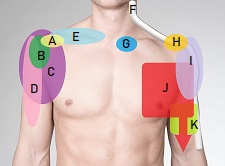- Home
- Diagnosis Guide
- Lump On Arm
Lump On Shoulder
Written By: Chloe Wilson BSc (Hons) Physiotherapy
Reviewed By: SPE Medical Review Board
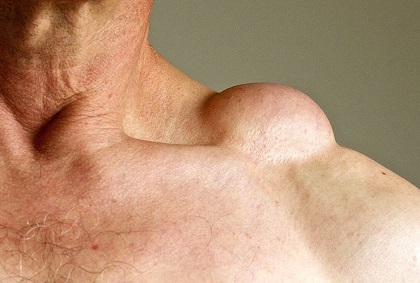
A lump on the shoulder or upper arm is a common problem that may be caused by a number of different things.
Shoulder lumps may be the result of an injury such as a fall or an MVC which may have broken or dislocated one of your bones.
Or the lump on your shoulder may be from inflammation such as bursitis or a cyst. It may be a small, soft, mobile lump or a large, hard painful lump.
And what people tend to worry about most is that they may have a cancer lump on their shoulder, but that is very rare and in most cases, a lump on the shoulder will settle down within a few weeks.
What Causes Shoulder Lumps?
Here we will look at the most common causes of lumps on shoulders, how to work out which one you have, how to treat them and what signs to watch for in case something serious is going on.
Here we will look at all the possible causes of lumps anywhere around the shoulder but you may also be interested in the Lump On Top Of Shoulder, Lump On Back Of Shoulder and Collarbone Lumps articles.
1. Fractures
If you have injured your shoulder through some sort of collision e.g. fall, sports or car accident and there is a lump on your shoulder, you may have broken one of the shoulder bones. Shoulder lumps from fractures can occur in the:
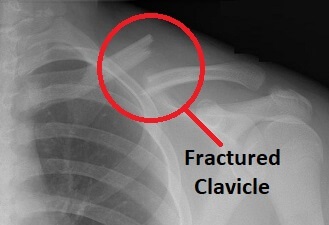
- Collarbone: aka clavicle fracture. Most common in children. Causes a bump on top of shoulder
- Shoulder Blade: aka scapular fracture. Rare. Causes a lump on back of shoulder blade
- Upper Arm Bone: aka humerus fracture. Most common type of shoulder fracture in adults. May occur at the top of the upper arm bone, known as a proximal humerus fracture, causing a lump on top of the shoulder or on the outer edge, or in the long section known as a humeral shaft fracture causing a lump in the upper arm.
The shoulder lump from a fracture may appear:
- Immediately: at the time of injury. A small bony lump on shoulder would indicate an undisplaced fracture (bones still aligned), a large shoulder lump would indicate a more severe fracture with the bones having moved out of place
- Delayed: may appear later as the bone heals due to excessive bone growth - common cause of lump on clavicle
A lump on the shoulder from a fracture will usually be very painful, particularly if you touch it. Depending on the severity of the break, it may be left to heal naturally, you may need to wear a sling, or surgery may be advised.
Find Out More: Shoulder Fractures
2. Joint Dislocation
A shoulder lump after a traumatic event may indicate a dislocation rather than a fracture. A dislocation is where one of the bones pops out of its usual place in the joint resulting in an obvious deformity. There are two types of dislocation that can cause a lump on the shoulder:
- Shoulder Dislocation: where the head of humerus is pushed out of its socket. In most cases the upper arm bone is pushed forwards, known as an anterior dislocation. There will be a large lump at the front of the shoulder and people typically support their arm across their body and avoid using their arm
- ACJ Dislocation: The acromioclavicular joint is the joint between the collarbone and the shoulder blade. An ACJ dislocation occurs when the shoulder blade is forced down which can result in a bump on top of shoulder known as a step deformity
Find Out More: Dislocated Shoulder
3. Muscle Contusion
A lump in an arm muscle after direct impact may indicate muscle damage rather than a broken bone. With a muscle contusion the muscle fibres are injured due to blunt force trauma, causing swelling and sometimes a bruise with a lump on the shoulder muscle or in the upper arm.
In some cases a haematoma may form (a collection of blood) causing a hard lump in the arm muscle. Whilst it may be uncomfortable for a while, a shoulder or arm contusion usually heals quickly with home treatment.
4. Lipoma
A soft fatty tissue lump on the shoulder is often a lipoma, a non-cancerous tumour where a fatty mass forms underneath the skin. Lipomas are common affecting around 1 in a 1000 people, usually between the ages of 40-60.
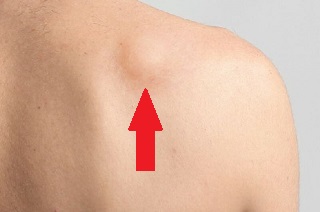
Lipoma shoulder lumps may form:
- Superficially: aka subcutaneous, just under the skin
- Deeply: between or within muscles – harder to feel
No-one knows why lipomas form but there is a genetic link so if someone in your family has had a lipoma soft tissue lump on their arm, you are at increased risk of developing them.
A lump on the shoulder caused by a lipoma is usually:
- Soft & Rubbery
- Round or Oval Shaped
- Pliable: moves easily
- Painless: unless pressing on a nearby structure e.g. nerves or blood vessels
- Fairly Small: usually less than 2inches in diameter but can grow much larger
- Slow Growing
Most lipoma lumps on the shoulder are completely harmless and don’t require any treatment, but if they are causing problems, they can be removed surgically.
5. Muscle Knot
A muscle knot is a common cause of a lump on the back of the shoulder, around the shoulder blade, or in the neck. Also known as myofascial trigger points, knots are small, hard lumps caused by tension, spasming or tearing in the muscle fibres.
The trapezius muscle on the back of the shoulder, neck and upper back is a really common place to get muscle knots and these small, firm lumps are often painful to touch. The best way to treat muscle knots are a combination of stretches, massage, heat and posture re-education.
Find Out More: Trapezius Pain & Trigger Points
6. Cysts
Another common cause of a painless lump on the shoulder are cysts, small sacs or lumps that may be filled with a substance such as fluid, pus or air and look similar to a blister. Shoulder cysts are very common and in most cases are completely harmless.
There are a number of different types of cyst but the ones that most often cause a lump on the shoulder are:
- Epidermoid Cysts: aka sebaceous cysts are one of the most common types of cyst to cause a lump on shoulder. Epidermoid cysts are small sacs filled with the protein keratin that sit just below the skin. They typically affect people under 40
- Ganglion Cysts: fluid-filled swelling that develops near a joint or tendon. Most common in the wrist and hands, but can occur at the AC joint or the shoulder joint. Ganglion cysts often develop in conjunction with labrum tears in the outer rim of the shoulder socket and are known as paralabral cysts
A lump on the shoulder from a cyst is usually:
- Rounded or Dome shaped
- Yellow or white
- Painless: unless infected when they appear red and swollen with foul smelling pus
- Fairly Small: pea sized to a few centimetres in diameter
- Slow Growing
You can find out more about cystic lumps on the shoulder and how to treat them in the Shoulder Cysts section.
7. Shoulder Bursitis
Another possible cause of a lump on the shoulder is bursitis. Bursa are small, fluid-filled sacs that sit between soft tissues and bones to provide cushioning. Shoulder bursitis is where one of the bursa becomes inflamed, usually from repetitive friction or an injury which can lead to a lump on the shoulder that hurts when any pressure is placed on the affected bursa.
There are a number of different bursa around the shoulder, any of which can become inflamed, but the most common are:
- Subacromial Bursitis: small bump on top of the shoulder and gradually increasing pain when raising the arm above your head
- Subscapularis Bursitis: growth or lump on back of shoulder blade causing constant dull, aching scapular pain and a snapping/grinding noise when moving the arm
Treatment for shoulder bursitis usually consists of a combination of rest, ice, physical therapy, injections, exercises and occasionally surgery. Find out more about Shoulder Bursitis Treatment.
8. Abscess
A painful lump on the shoulder may be caused by an abscess, a collection of infected pus that forms deep below the skin, usually caused by a bacterial infection. The pus in an abscess is made up of white blood cells, dead tissue and bacteria.
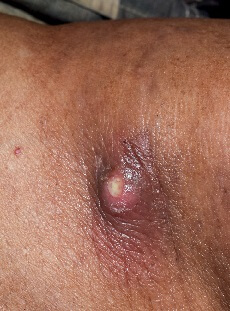
A shoulder lump caused by an abscess usually presents as:
- Round, firm lump on shoulder: squashy not hard
- White or yellow pus: under the skin which may ooze out
- Painful: lump on shoulder that hurts or is tender to touch
- Signs Of Infection: fever, feeling unwell, warm to touch
- Fairly Small: 1-3cm diameter but can grow larger
A small abscess lump on the shoulder (less than 0.5cm) should settle by itself – it can help to apply a warm compress for 30 minutes 3-4x daily, but larger abscess often need to be drained by your doctor to remove the infected fluid
9. Shoulder Acne
Shoulder acne can also cause lumps on the shoulders and arms. Shoulder acne ranges from a few small white or black heads, to a large covering of pus filled spots.
Acne lumps under the skin on the shoulders and arms may be caused a range of things including excess oils that block glands, allergic reactions, blocked hair follicles and excess keratin. One of the most common types of acne to causes small lumps on the upper arm is keratosis pilaris.
Find Out More: Shoulder Acne Causes & Treatment
10. Cancer
Many people worry when they find a lump on their shoulder that it may be cancer. In most cases, shoulder lumps are completely benign i.e. non-cancerous, but any new lumps should always be taken seriously.
There are a few different types of cancer that can cause a lump on the shoulder or upper arm, the most common being:
- Soft Tissue Sarcoma: tumour that forms in connective tissue i.e. muscles, tendons or nerves. Rare and usually painless
- Skin Cancer: a skin cancer lump on arm or shoulder may appear like a discoloured patch, a red firm lump or a flat scaly area of skin, depending on the type of skin cancer. A common sign of a melanoma is a new or changing mole which tend to be irregularly shaped and may be itchy and bleed. If you notice a new mole or a mole that has changed in size, colour or shape, get it checked out by your doctor
A soft, mobile shoulder lump is unlikely to be cancerous. A cancerous lump on shoulder often grows quite rapidly, changes shape or colour, and is hard and non-mobile. If you have a lump on your shoulder like that or you are experiencing unexplained weight loss, fatigue, are feeling unwell or find that your shoulder pain is mainly at night, see your doctor as soon as possible.
11. Shoulder Arthritis
Another possible cause of shoulder lumps is arthritis. The term arthritis simply means joint inflammation and refers to a number of different conditions. The most common types of arthritis to cause shoulder lumps are:
- Rheumatoid Arthritis: an autoimmune inflammatory disease where the immune system attacks healthy cells. Around 1 in 5 people with RA develop nodules in their joints, such as the hands or shoulders
- Osteoarthritis: a degenerative arthritis that can lead to the formation of bone spurs, excess bone growth causing a hard lump on the shoulder. Most common in people over the age of 65
- Gout: an inflammatory arthritis caused by a build-up of uric acid which forms tiny crystals in and around joints. Shoulder gout can be extremely painful and the joint may be hot, red and swollen. Shoulder gout is rare, gout is much more likely to affect the hands and feet.
When To See Your Doctor
In most cases a lump on the shoulder is nothing serious and will usually settle down on its own in a couple of weeks, but if you have any of the following symptoms, you should seek medical attention as soon as possible:
- Fast Growing Lump
- Painful Lump: lump on shoulder that hurts when using your arm or is tender to touch
- Very Large Lump: or abnormal shape
- Lump Developed Following An Injury
- Feeling Unwell: fever, fatigue, weight loss
- Severely Restricted Movement: shoulder or arm
Depending on the size, location and history of your shoulder lump, your doctor may send you for a biopsy, ultrasound, MRI or CT scan to make an accurate diagnosis
Shoulder Lump Treatment
There are many different treatments for lumps on the shoulder depending on the underlying cause, which may involve:
- Aspiration: drainage of excess or infected fluid using a fine needle
- Surgery: for shoulder fractures or to remove the growth
- Medication: pain relief and anti-inflammatories
- Relocation: If your shoulder lump is due to a dislocation, the bones will need to be re-positioned by a qualified medical professional – don’t try to relocate the joint yourself as this can cause more damage
- Physical Therapy: Rehab programme to regain full strength and mobility in the shoulder, massage, and ultrasound. Stretches and strengthening exercises can be particularly helpful.
- Cancer Treatment: Depending on the type, stage and location of your cancer you may need a combination of surgery, radiotherapy and/or chemotherapy
What Is Causing My Shoulder Lump?
There are lots of different things that can cause lumps on shoulders but by thinking about your specific symptoms you can work out what is wrong:
- Hard Lump On Shoulder: fracture, dislocation, arthritis
- Lump Between Neck And Shoulder: Knot, ACJ injury
- Bump On Top Of Shoulder: Clavicle injury, proximal humerus fracture, subacromial bursitis, arthritis
- Lump On Back Of Shoulder: muscle knot, arthritis, cyst
- Small Lump On Shoulder Blade: Scapula fracture, scapulothoracic bursitis, tumor
- Lump On Shoulder That Hurts: If you have a painful lump on your shoulder it may be from bursitis, trigger point, fracture, dislocation, abscess, gout
- Lump Under Skin On Shoulder: lipoma, cyst, muscle contusion, acne
- Cancer Lump On Shoulder: rapid growing, non-mobile, firm, change in appearance e.g. of mole, unexplained weight loss, fatigue, night pain
- Large Lump On Shoulder Bone: displaced fracture, dislocation
- Lump On Clavicle: Collarbone injury, cyst
- Fluid Lump On Shoulder: cyst, bursitis, abscess
- Lump on Shoulder Muscle: contusion, lipoma, cyst
- Bruise With Lump On Arm: muscle contusion, fracture
What Else Can Help?
Hopefully you now have a much better idea of what is causing the lump on your shoulder, but if you want more help working out what is wrong, or have other symptoms in your shoulder or upper arm, check out the shoulder pain diagnosis guide.
You may also be interested in the following articles:
- Bump On Top Of Shoulder
- Lump On Back Of Shoulder
- Lump On Collarbone
- Burning Shoulder Pain
- Shoulder Pain At Night
- Upper Arm Pain
- Upper Back Pain
Related Articles
Medical & Scientific References
- Buoy Health: Shoulder Bump
- Healthline: Lump On Shoulder
- Manchester Lumps Clinic: When Should I Be Worried About A Shoulder Lump?
- NIDirect Government Services: Lumps & Swellings
- American Journal Of Roentgenology: MRI of Cystic and Soft-Tissue Masses of the Shoulder Joint
Page Last Updated: November 5th, 2024
Next Review Due: November 5th, 2026

